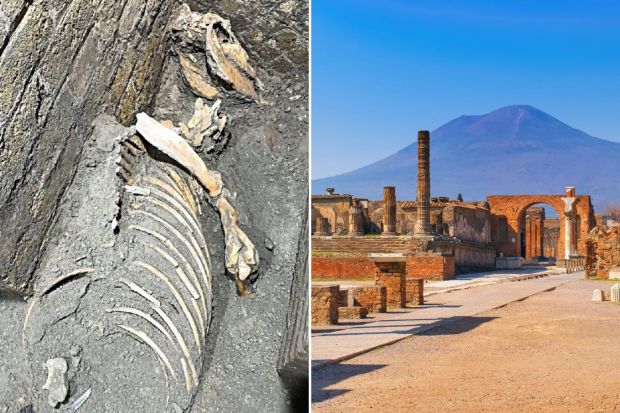Science
New Evidence Shows Romans Returned to Pompeii After Eruption

New archaeological findings have revealed that Romans returned to the ancient city of Pompeii after the catastrophic eruption of Mount Vesuvius in 79 AD. This striking evidence challenges the long-held belief that the city was permanently abandoned following the disaster, which resulted in the deaths of thousands and left Pompeii buried under volcanic ash.
Previously, little was known about the aftermath of the eruption, which occurred nearly 1,946 years ago. The city, located near modern-day Naples in the Campania region of Italy, was once a bustling hub of Roman life. Experts have long speculated that some survivors may have returned, but solid evidence remained elusive until now.
Insights from Recent Excavations
Archaeologists have discovered compelling signs of life returning to the ruins, particularly among the poorer inhabitants who could not afford to relocate. Many of these individuals sought to reclaim valuables left behind by wealthier citizens among the rubble. The upper floors of some buildings were reoccupied, while the ground floors underwent significant transformations, becoming cellars equipped with ovens and mills.
According to Gabriel Zuchtriegel, the site director of Pompeii Archaeological Park, “Thanks to the new excavations, the picture is now clearer: post-79 Pompeii reemerges, less as a city than as a precarious and grey agglomeration, a kind of camp, a favela among the still-recognisable ruins of the Pompeii that once was.” This new perspective offers a glimpse into the resilience of the city’s former inhabitants in the face of disaster.
Despite earlier evidence of post-eruption occupation, much of it was overlooked in the rush to uncover the vibrant frescoes and well-preserved homes of Pompeii. Zuchtriegel noted that “the faint traces of the site’s reoccupation were literally removed and often swept away without any documentation.” The focus on the destruction in 79 AD has overshadowed the story of survival and adaptation that followed.
The Legacy of Pompeii and Mount Vesuvius
The city of Pompeii, along with the nearby town of Herculaneum, was buried under layers of ash during the eruption of Mount Vesuvius, which released thermal energy estimated to be a hundred thousand times that of the atomic bombings in Hiroshima and Nagasaki. While the exact death toll remains uncertain, estimates suggest that between 15% and 20% of the city’s population perished due to the thermal shock from the eruption.
Pompeii remained largely uninhabited for approximately 1,500 years until its rediscovery in 1599 and subsequent excavations that began in the 18th century. The remains of the city have been preserved for centuries due to the lack of air and moisture in the volcanic ash.
In recent years, excavations have continued to yield significant discoveries. For instance, researchers recently uncovered the skeleton of a crouching child, who tragically succumbed to the eruption. Mount Vesuvius, considered one of the most dangerous volcanoes in the world, has erupted around three dozen times since 79 AD, with the most recent eruption occurring in 1944.
Today, the volcano poses a risk to approximately three million people living in its vicinity. Although it is currently classified as dormant, experts describe Vesuvius as “extremely active” and unpredictable.
The new findings from Pompeii not only reshape our understanding of life after the eruption but also highlight the enduring human spirit in the face of calamity. As excavations continue, archaeologists look forward to uncovering more stories from this ancient city, revealing the complexities of survival amid the ruins.
-

 Entertainment1 week ago
Entertainment1 week agoAimee Osbourne Joins Family for Emotional Tribute to Ozzy
-

 Politics2 weeks ago
Politics2 weeks agoDanny Healy-Rae Considers Complaint After Altercation with Garda
-

 Top Stories3 weeks ago
Top Stories3 weeks agoFianna Fáil TDs Urgently Consider Maire Geoghegan-Quinn for Presidency
-

 World3 weeks ago
World3 weeks agoHawaii Commemorates 80 Years Since Hiroshima Bombing with Ceremony
-

 World3 weeks ago
World3 weeks agoGaza Aid Distribution Tragedy: 20 Killed Amid Ongoing Violence
-

 World3 weeks ago
World3 weeks agoCouple Convicted of Murdering Two-Year-Old Grandson in Wales
-

 Top Stories4 weeks ago
Top Stories4 weeks agoClashes Erupt Between Far-Right Groups and Migrants in Spain
-

 World4 weeks ago
World4 weeks agoAristocrat Constance Marten and Partner Convicted of Infant Murder
-

 Top Stories3 weeks ago
Top Stories3 weeks agoHistoric Dalkey Pub The Queens Reopens Under New Management
-

 World3 weeks ago
World3 weeks agoTrump Defends FBI Deputy Director Amid Epstein Files Controversy
-

 Business4 weeks ago
Business4 weeks agoSunshine 106.8 Boosts Irish Music After Regulator’s Request
-

 Politics3 weeks ago
Politics3 weeks agoTragic Crowd Surge at Gaza Aid Center Claims 20 Lives









